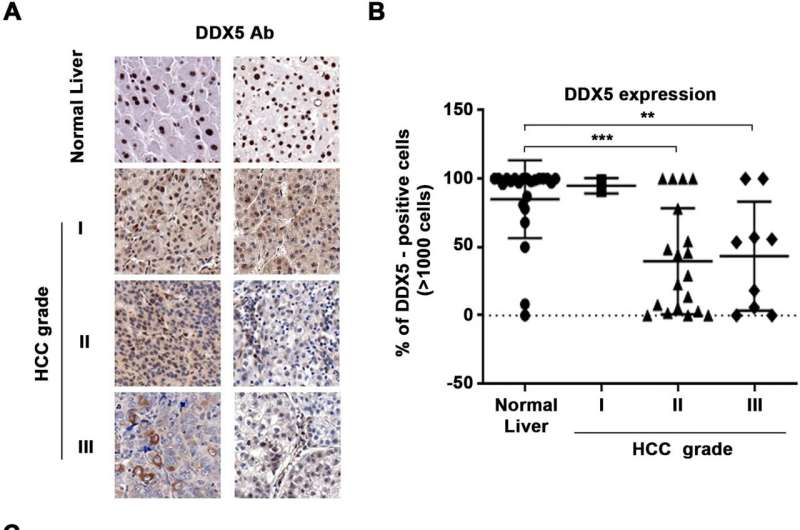This article has been reviewed according to Science X's editorial process and policies. Editors have highlighted the following attributes while ensuring the content's credibility:
fact-checked
trusted source
proofread
Discovery points to new approach to treating liver cancer

A breakthrough in the understanding of the relationship between a naturally occurring enzyme and the liver cancer drug sorafenib could improve the effectiveness of the drug, which currently prolongs the life of liver cancer patients for only two to three months. A study of the relationship between the enzyme DDX5, liver cancer sorafenib, published in the journal Cell Death & Disease, points to the potential for a more effective therapy that combines existing anti-cancer drugs with treatments that spur production of this enzyme.
"If we can find a way to continuously express DDX5 in the liver during treatment, then sorafenib and other multi-tyrosine kinase inhibitors have much better anti-tumor efficacy," said Ourania Andrisani, lead researcher and Distinguished Professor of Basic Medical Sciences in the College of Veterinary Medicine at Purdue University. "This is a foundational discovery, and from this, we can think of new ways to develop effective therapies for liver cancer."
More than three-quarters of a million people worldwide die annually from liver cancer, and survival rates, even in affluent countries, remain poor, ranging from less than 10% in several European countries to 30% in Japan, according to a 2022 article published in the Journal of Hepatology.
More than half of liver cancer cases worldwide are caused by chronic infection by the hepatitis B virus (HBV), which is one of Andrisani's research topics. As part of her investigations into HBV, Andrisani is tracing the role of DDX5 in the biosynthesis of the virus. DDX5—one of a class of proteins called RNA helicases that modify the structure of RNA—is involved in all aspects of RNA biology.
In the new study, Andrisani's team tackles the relationship between DDX5 and sorafenib, a well-established treatment against liver cancer whose effectiveness is short-lived. In an analysis of liver cancer cells and health care records from patients treated with sorafenib, patients with higher levels of DDX5 lived longer than those with lower levels.
Intriguingly, sorafenib itself decreased levels of DDX5 in liver cancer cells and liver cancer animal models, and RNA sequencing indicates that the drug activates genes indispensable to the Wnt/β-catenin pathway, a series of molecular steps normally active during embryonic development of the liver and associated with liver cancer when improperly activated.
Next, using engineered liver cancer cells, the research team showed that boosting DDX5 protein levels improves the efficacy of sorafenib in reducing the growth of liver tumors. The liver cancer cells were engineered to turn on the production of the DDX5 protein when treated with the antibiotic doxycycline.
Tumors generated from the engineered cells implanted in mice were treated with sorafenib either together with doxycycline or without doxycycline as a control. The tumors treated with doxycycline were significantly smaller by weight than those not spurred to produce high levels of DDX5. During a two-week treatment of the mice with sorafenib and doxycycline to make DDX5, the tumor weight was reduced by an average value of 50%, while doxycycline alone or sorafenib alone did not have a significant effect on tumor weight.
In previous work, Andrisani's team found that DDX5 inhibits HBV replication and that levels of DDX5 drop with chronic HBV infection. Her work also shows that DDX5 helps to repress the Wnt/β-catenin pathway.
Andrisani said a potential therapy based on the new findings would involve delivering mRNA to liver cells, causing them to produce DDX5 protein, just as mRNA was used in the COVID-19 vaccine to direct cells to make the viral protein.
"We're hopeful that this finding will inspire therapeutics that take advantage of this mechanism," Andrisani said. "It would be a clean, neat approach because we could target the cancer cells within the liver and continue the treatment only for as long as the patient is taking sorafenib. Once the treatment is over, delivery of DDX5 mRNA will also stop."
More information: Zhili Li et al, RNA helicase DDX5 modulates sorafenib sensitivity in hepatocellular carcinoma via the Wnt/β-catenin–ferroptosis axis, Cell Death & Disease (2023). DOI: 10.1038/s41419-023-06302-0




















